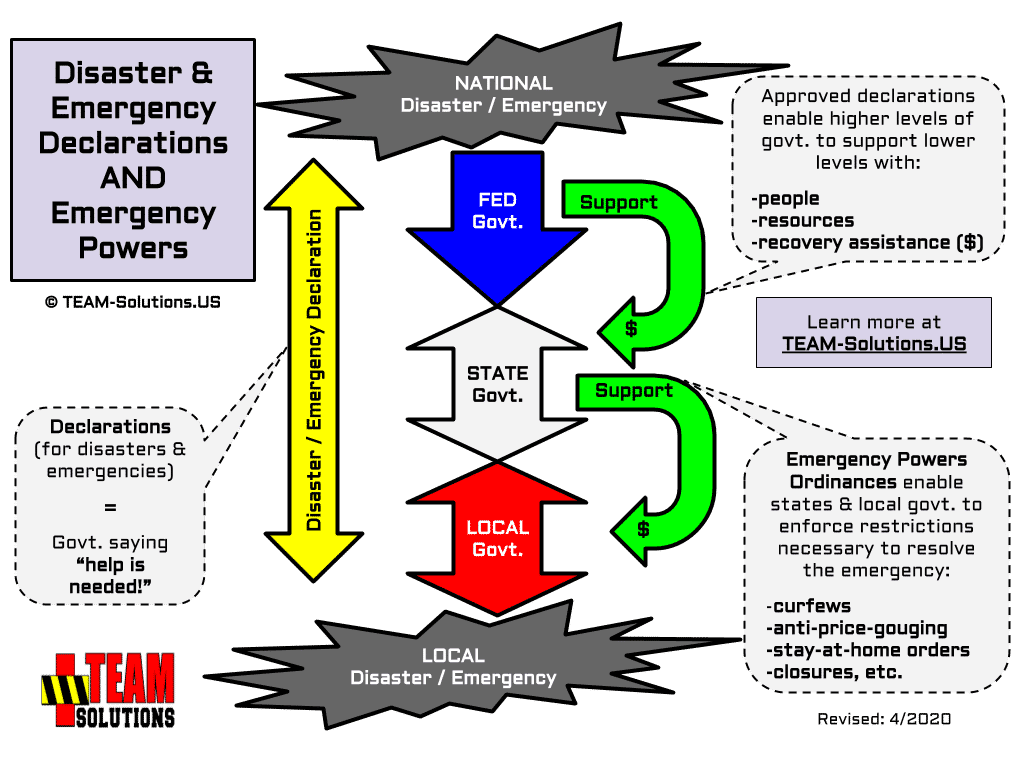Disaster and Emergency Declarations
Imagine this ... a global pandemic is impacting the entire country (USA).
You see news reports that several governors and the president "declares a national emergency."
The declaration is simply the government recognizing that there's an emergency at-hand and are saying: "help is needed."
Not hyperbole either ... it's been our country's procedure since 1976 when the process was formalized.
- Emergency declarations and disaster declarations serve essentially the same purpose.
- The difference is defined mainly by the amount of support requested.
- These declarations are temporary but renewable for the length of a disaster.
Each impacted state and local government also declares a disaster in order to receive support from a higher level of government. Emergency support comes in the form of:
- People
- Things
- Money
In addition to resources that are provided, a percentage of the money spent by state and local government in their response efforts is also eligible for reimbursement.
Emergency Powers Ordinances
When an emergency or disaster is declared by the President, Congress authorizes 136 special powers available to the President to help the country overcome the crisis, including:
- Suspending federal regulations
- Requiring private factories to make response-related products (Defense Production Act of 1950)
- Enacting the Robert T. Stafford Disaster Relief and Emergency Assistance Act, etc.
States and local government also enact temporary laws (ordinances) that aid their efforts to recover swiftly from the emergency. They're called Emergency Powers Ordinances and they can enable restrictions, including:
- Curfews and shelter-in-place orders
- Suspensions of liquor sales
- Closures of non-essential businesses
- Reductions of procurement policies
- Restrictions on price-gouging, etc.
Emergency Powers must also be renewed regularly and are often inherited from the next higher level of government.
Declaration Examples
During the global coronavirus COVID19 pandemic of 2020, emergency declarations and emergency powers blanketed much of America.
Below are the declarations that were applicable during the middle of the US government's response. My home state of Texas, my county and my city are presented below as a reference, in descending order.
- USA's Presidential Declaration - effective March 1, 2020. (As of 1/27/2021, this document is not accessible.)
- State of Texas Disaster Declaration - 1st issued by Governor on March 13, 2020 (renewed every 30 days) and introduced wide-ranging statewide restrictions.
- Tarrant County Disaster Declaration - issued by the County Judge on March 21, 2020 (renewed every 30 days) and introduced wide ranging community restrictions.
- City of Hurst Disaster Declaration - issued by the Mayor on March 18, 2020 (renewed every 30 days) and introduced wide ranging community restrictions.
The declaration process outlined herein already occurs over 30 times in a typical year when communities are impacted by destructive natural disasters such as floods, wildfires, tornadoes and hurricanes.
To deepen your understanding of this process, links to the expanded legal explanation of the declaration process are included in the Additional Reading section.
Here's a simple flow-chart of what the completed process looks like (click to enlarge):

The US Constitution
The US Constitution grants the President the power to declare a national emergency.
The National Emergencies Act of 1976 empowers the President to use any of a long list of emergency powers.
“With respect to acts of Congress authorizing the exercise, during the period of a national emergency, of any special or extraordinary power, the President is authorized to declare such national emergency”
During a public health emergency, such as a pandemic, the 10th Amendment grants significant power to each state to require and enforce:
- Reporting & Surveillance
- Epidemiological investigation
- Vaccination (voluntary / involuntary)
- Isolation (voluntary / involuntary)
- Treatment (voluntary / involuntary)
- Other social distancing measures
- Evacuation
- Powers over property
As long as the restrictions are narrowly defined, even gun possession can be limited during a state of emergency. Refer to the Additional Reading section for a case study.
As previously stated, these actions and other emergency powers are predicated on a duly-authorized emergency declaration to ensure legality and proper supervision.
Also note that the power to establish restrictions are guided by federal authorities but fall to each state to determine ultimately how they will be implemented.
- Local government is beholden to state government, who is guided by the federal government.
- So that's why, when neighboring states are impacted by the same disaster, one may force an evacuation, require businesses to close, etc. and the other state may choose not to.
- Even when their choices run counter to federal recommendations, states have dominion over what happens within their state.
The "Myth of 100%"
Society reinforces our expectation that 100% is not only achievable in every activity but also probable.
In an emergency where the dynamics of a disaster and diverse human behavior (and attitudes) collide ... there will never be a 100% solution.
- All or nothing
- Agree or disagree
- Conservative or Liberal
- Pro-government or anti-government
If we want to experience a successful outcome, we must modify our definition of success.
Confirmation bias: Interpreting information that confirms pre-existing beliefs, while discarding other alternatives.
Confirmation bias makes this myth worse and, unfortunately, runs rampant during emergencies.
If one believes that the _______ is right/wrong/good/bad, etc., then every subsequent piece of data presented will be filtered and accepted based on whether that data supports their initial, one-sided belief.
Mindset
The inconvenience and unpleasantness of a disaster will never end soon enough nor will the effects ever be felt equally.
Therefore, living under a state of emergency requires resilience, compromise and the maturity to disagree with - yet support anyway - an imperfect plan to recover.
Left to fester, these great stresses eventually create great chasms between us. Some among us will lead purposely towards a recovery. Others among us choose to merely stand steadfast in their disagreement of how 'others' are handling things.
Leaders at every level understand those distinctions. And since you're reading this, I trust you are the former and not the latter example.
Your organization, your community and your family are better off for it.
When Will the Disaster be Over?

Easy question, complex answer. 'Over' to some doesn't mean it is over for all.
If you've read my book, The Response Leadership Sequence, you're already familiar with the phases necessary to put a disaster in our rear-view mirror for good.
Check the resources at my Crisis Recovery page. The resources are intended to provide a deeper understanding of 'forecasting vs. scenario planning' plus more about how, when and who brings a disaster to a close.
Pay particular attention the important distinction between forecasts (based on prior data) and scenarios (based on 'if this happens, then that is the likely result'):
- Forecasting the timeline of a tornado recovery is easier and more accurate (lots of data to refer to).
- However, forecasting the timeline of a global pandemic recovery that features complexity that no one alive has ever seen before (less data to refer to) is harder and less accurate.
- In the latter example, scenario planning is more useful because it defines - and empowers - what society must do ('if this happens') in order for the recovery to be swift and effective ('then that may happen').
Additional Reading
- 50 U.S.C. 1601 - National Emergencies Act
- 42 U.S.C. 5170 - Procedure for declaration
- 42 U.S.C. 5121 - Congressional findings and declarations (b) ... provide an orderly and continuing means of assistance by the Federal Government to State and local governments in carrying out their responsibilities to alleviate the suffering and damage which result from such disasters ...
- Bateman v. Perdue: Implications for Gun Restrictions During a State of Emergency
- Robert T. Stafford Disaster Relief and Emergency Assistance Act
- Legal references for Texas
- 'Crisis Recovery Planning: Global pandemics, regional disasters, or spilled coffee … learn the process to lead your organization to a new normal' by Mike McKenna
